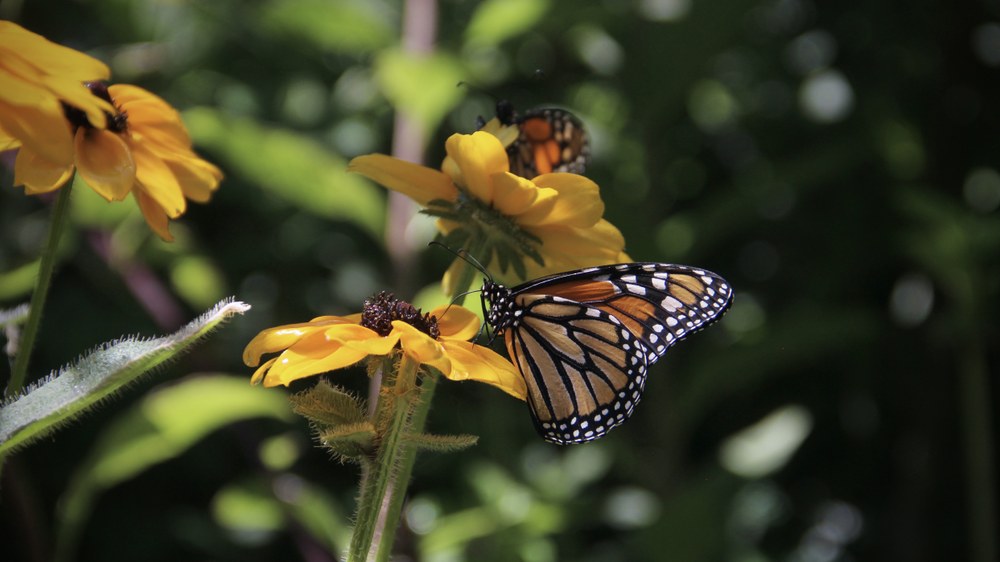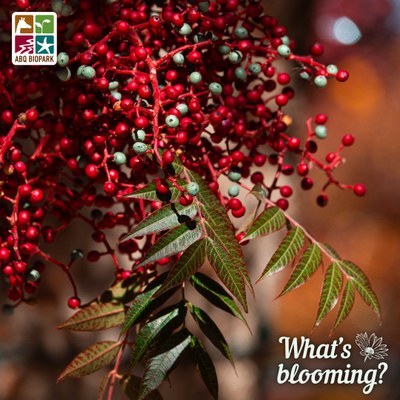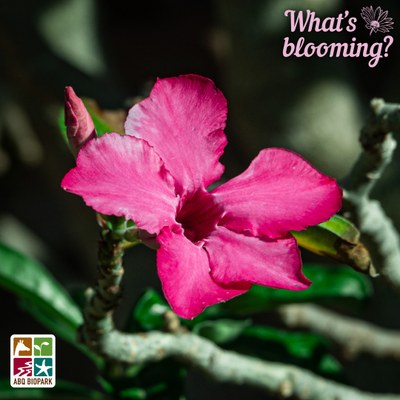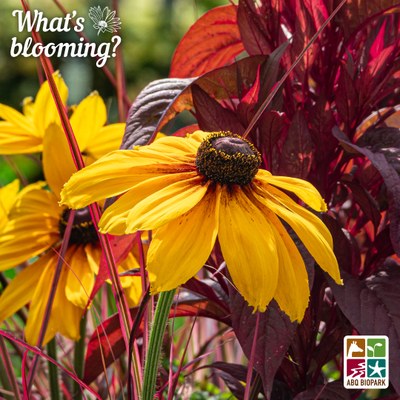Botanic Garden
Welcome to the ABQ BioPark Botanic Garden

Opened in 1996, the Botanic Garden has grown to 32 acres of exhibits, and showcases plants from the American Southwest and around the world.
The Botanic Garden’s BUGarium is one of the most elaborate exhibits dedicated to bugs and arthropods in the country.
The Travel Channel cites ABQ BioPark Botanic Garden as one of the top 12 in the country!
Seasonal Update:
Learn more about featured seasonal plants!
Rose grape, featured 12/3/25: The High Desert Rose Garden atrium has been transformed into a twinkling wonderland for the Botanic Garden’s holiday flower show! Centered in a shower of cascading blossoms among the palm trees, bromeliads, snake plants, ferns, and peach and gold poinsettias sit the beautiful Medinilla, or rose grape. Medinilla magnifica is a flowering tropical shrub native to the Philippines that naturally grows in the forks of large trees, but does not steal its nutrients from its host like a parasite would. Despite this habit, known as an epiphyte, it can be grown as an ornamental in containers indoors, in greenhouses, or sheltered patios and balconies. In addition to the bright pink flower clusters, its glossy dark green leaves are up to a foot long and evergreen as long as its kept warm. With an average overall size of two to four feet tall and up to three feet wide, this beauty will catch your eye all year.
The rose grape can’t tolerate temperatures below 59º F, or our scorching New Mexico sun, so grow yours indoors in bright but filtered light, similar to how you would grow an orchid. Insufficient light will reduce flowering, so keep this in mind when choosing a location. Medinilla will benefit from added humidity, especially when heaters are running in the winter. You can use a humidifier or set your plant on a deep tray filled with gravel or small pebbles and keep water in the tray at all times to raise humidity levels around the plant. Don’t skip the gravel as it is crucial to prevent the plant from becoming waterlogged. Medinilla can be moved outside in summer and placed in partial shade or indirect sun. However, sudden changes in temperature, light, or watering habits may cause leaf drop. Add a balanced fertilizer every month or so during the growing season to rich, well-draining soil to keep them happy, but stop in the dormant winter months as too much can cause the leaves to brown. Rose grapes require more maintenance than beginner-friendly plants, but they will enhance the indoor air quality and make a vibrant addition to any living space!

Chinese pistache, featured on 11/12/25: When you’re looking for a new tree for your city landscape, you’ll hardly find a better fit than the Chinese pistache, more precisely known as Pistacia chinensis. Native to much of Mainland China, this relative of the commonly eaten pistachio (Pistacio vera) is on the climate-ready tree list for Albuquerque and is a favorite for urban settings because in addition to many other wonderful attributes, its roots typically won’t lift concrete. Back to those other wonderful attributes…these medium-sized trees mature at around 30 feet tall and are tolerant of drought, heat, and pollution as well as being adaptable to most soils, long-lived, and even fire resistant! It doesn’t even end there: they are the most frost-tolerant of the Pistacia genus and are treasured for their dramatic fall leaf colors and scaly bark that gives way to a rich salmon color when it flakes off. The only thing they don’t do is provide edible nuts for humans like P. vera, but the fruit provided by the female tree that ripens from a rich red to a soft blue-green are a treat for birds who then help propagate the tree by spreading the seeds. So in trade, they will attract native wildlife to your home garden!
Though they make a great shade tree, they don’t want any for themselves and thrive in full sun. To get good form and a symmetrical tree, pruning is recommended in the early years, ending up with a rounded umbrella-like canopy when it matures. Both male and female trees bloom with small flowers in spring, but only the females will produce the small berries come fall. Some gardeners prefer the tidier male tree for that reason alone, but no matter which you choose you are guaranteed an eye-catching addition to your home! The festive holiday color palette is on full display outside the entrance to the Spanish-Moorish Garden on the female Chinese pistache pictured.

Desert rose, featured on 10/29/25: This succulent shrub in the dogbane family is native to desert regions of Africa and the Arabian Peninsula, and goes by the scientific name Adenium obesum. Brightly colored flowers bloom among clusters of bright green leaves at the tips of light-colored branches growing from the thick stem that stores water, making it highly drought-tolerant. The base, or caudex, is usually bulbous and gnarled, each its own unique sculpture, and they are often cultivated as a bonsai or potted since they can grow over 10 feet tall and five feet wide in their native habitat.
Native desert-dwellers can make a great water-conscious choice here in Albuquerque and they thrive well in the heat in full sun, but the typically evergreen plant may lose its leaves during times of drought or dormancy during our colder winters if not protected. If not already indoors, they should be moved in when temperatures dip below 55º F. Soil should be well-draining and not allowed to dry out too much during their growing season. With the right care they can flower multiple times throughout the year, though the typical season is spring and summer when clusters of large, vibrant flowers in shades of pink or red dazzle in contrast with the foliage. But, this desert rose does have its metaphorical “thorn”: All parts of Adenium obesum are toxic, the sap has even been used to poison arrowheads! Take caution to keep it in a location safe from children, pets, and livestock; and use gloves when handling it yourself!
Pictured: in the Desert Conservatory

Rudbeckia, featured 10/22/25: Arrangements throughout the Botanic Garden help bring on the fall atmosphere with traditional pumpkins and gourds, the dark red of celosia, and a bright pop of yellow from rudbeckia! Species in the genus Rudbeckia, around 31 in total, and all are native to North America. The dark-colored raised center inspired the common name black-eyed Susan, but some are known as coneflowers. Species in this genus can be annual, biennial, or perennials and some are more hardy in our hot summers than others, but they are beloved for providing a pop of warm yellow to orange tones late into summer with their long blooming seasons.
Here in Albuquerque, Rudbeckia fulgida is a great perennial choice that can take the heat while Rudbeckia hirta is less tolerant of the hot, dry summers and will behave more like an annual, but both are somewhat drought tolerant. Typically standing erect at around 2 to 3 feet tall, these wildflowers can thrive in many different types of gardens or containers in a moderate variety of well-drained soils and look great when planted en masse. Additionally, the large flowers can be about 6 inches across making them a nice landing pad for many types of pollinators, a host plant for some types of moths, and a source of seeds for many species of birds. With many cultivars available, Rudbeckia is ready to stand up and stand out for you, too!
Pictured: Rudbeckia 'Sunbeckia Marilyn'

No results were found.
